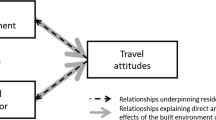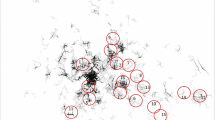Abstract
Recent studies that estimated the land use–travel relationship while controlling for residential self-selection mostly acknowledged the potential for the self-selection in the reverse direction according to learning and self-justification over time. Thus, this study empirically tests how the relationship varies by the length of time after residential move in Seoul, South Korea. Analytical results show that population density encourages the choice of automobile alternatives in extreme cases, that is, for newly moved first-year residents who decided to tolerate congestion and for longtime residents of 4 years or more who had a due chance to learn and appreciate neighborhood travel options and also, it extends commuting time for these short and longtime residents. Employment density reduces commuting time for all but longtime residents because of better jobs–housing balance while it is not necessarily accompanied by mode choice variations. Street intersection density is associated with commuting time variations in all cases. Land use balance entropy is unrelated to the time variations, but consistently related to the alternative mode choice, and possibly beneficial to trip-chaining. While public transit densities are classified into subway and bus densities, the former turns out to be significant regarding commuting time and mode choice for most residents, but the latter only for first-year residents. Particularly on the mode choice, the gradual learning effect is associated with subway density (significant after 1 year), whereas the self-justification effect by bus density is rather quick, but not lasting (significant only for 1 year).
Similar content being viewed by others
Availability of data and materials
Data used for empirical analyses are available online: https://drive.google.com/file/d/1qnq41hyrEBYsqu9pkb1FeAjeBwnxHKA1/view?usp=sharing.
Code availability
Not applicable.
Notes
A few other studies set five years, not four years, as a criterion of long residence. In their study conducted in Portland, Sun et al. (1998) found a significant VMT (vehicle miles traveled) difference by length of residence, and specifically, if their residence is five-plus years, people had 11% more VMT. Ma (1999) conducted a survey in Korea and described the shape of the relationship between the length of residence and ratio of those who choose the automobile. The relationship firstly had a linear slope in the first four years and then, presented an inflection point in the fifth year after which it became flattened. Thus, this study separated the sample of four-year-plus residents into two samples and specified analytical models for four-year and five-plus-year residents, respectively. However, the two did not carry meaningful differences. Consequently, for efficiency and clarity, this study delivers analytical results from a model based on the combined sample. For details, see Appendix.
While the psychometric approach is a long-standing convention in the travel behavior literature (Nicolaidis 1977), measuring travel-related attitudes with a single survey item was also found to be accurate (Bohte et al. 2009) and including observed indicator variables instead of unobserved components in an empirical model could also be desirable because by definition (i.e., observed), they are easier to measure (to check the current conditions) and control (for policy interventions).
References
Ali MI, Abidin MR (2018) Population density and intensity of traffic connection: spatial analysis (overlay). Int J Sci Res 7:546–552
Altshuler B (1981) Modeling of dose-response relationships. Environ Health Perspect 42:23–27. https://doi.org/10.1289/ehp.814223
Aneshensel CS (2002) Theory-based data analysis for the social sciences. https://doi.org/10.4135/9781412986342
Babbie E (2004) The practice of social research . Thomson, Wadsworth
Beatty C, Foden M, Lawless P, Wilson I (2007) New deal for communities national evaluation: an overview of change data 2006. Department for Communities and Local Government, London, UK
Boarnet M, Crane R (2001) The influence of land use on travel behavior: specification and estimation strategies. Transp Res A 35:823–845
Bohte W, Maat K, van Wee B (2009) Measuring attitudes in research on residential self-selection and travel behaviour: a review of theories and empirical research. Transp Rev 29:325–357
Cao X (2009) Disentangling the influence of neighborhood type and self-selection on driving behavior: an application of sample selection model. Transportation 36:207–222
Cao X (2010) Exploring causal effects of neighborhood type on walking behavior using stratification on the propensity score. Environ Plan A 42:487–504. https://doi.org/10.1068/a4269
Cao X (2014) Residential self-selection in the relationships between the built environment and travel behavior: introduction to the special issue. J Transp Land Use 7:1–3
Cao X, Mokhtarian PL, Handy SL (2007) Cross-sectional and quasi-panel explorations of the connection between the built environment and auto-ownership. Environ Plan A 39:830–847
Cao X, Mokhtarian PL, Handy SL (2009) Examining the impacts of residential self-selection on travel behaviour: a focus on empirical findings. Transp Rev 29:359–395
Ewing R, Cervero R (2010) Travel and the built environment: a meta-analysis. J Am Plann Assoc 76:265–294
Gim T-HT (2012) A meta-analysis of the relationship between density and travel behavior. Transportation 39:491–519. https://doi.org/10.1007/s11116-011-9373-6
Gim T-HT (2016) Testing the reciprocal relationship between attitudes and land use in relation to trip frequencies: a nonrecursive model. Int Reg Sci Rev 39:203–227
Gim T-HT (2018) Land use, travel utility, and travel behavior: an analysis from the perspective of the positive utility of travel. Pap Reg Sci 97:S169–S193
Gim T-HT (2019) Examining the effects of residential self-selection on internal and external validity: an interaction moderation analysis using structural equation modeling. Transp Lett 11:275–286
Giuliani MV (2003) Theory of attachment and place attachment. In: Bonnes M, Lee T, Bonainto M (eds) Psychological theories for environmental issues. Ashgate, Aldershot, pp 137–170
Guo D, Wu J (2013) Understanding spatiotemporal patterns of multiple crime types with a geovisual analytics approach. In: Leitner M (ed) Crime modeling and mapping using geospatial technologies. Springer, Dordrecht, pp 367–385
Handy SL (2005) Does the built environment influence physical activity? Examining the evidence: critical assessment of the literature on the relationships among transportation, land use, and physical activity. TRB special report 282
Harlan SL et al (2005) Neighborhood attachment in urban environments. Paper presented at the annual meeting of the American Sociological Association, Philadelphia, PA, August 13–16, 2005
Johnston R, Propper C, Sarker R, Jones K, Bolster A, Burgess S (2005) Neighbourhood social capital and neighbourhood effects. Environ Plan Econ Space 37:1443–1459. https://doi.org/10.1068/a37222
Kim YS (2011) Application of the cognitive dissonance theory to the service industry. Serv Mark Q 32:96–112. https://doi.org/10.1080/15332969.2011.557602
Krizek KJ (2003) Residential relocation and changes in urban travel: does neighborhood-scale urban form matter? J Am Plann Assoc 69:265–281
Lee Y, Guhathakurta S (2018) An analysis of the effects of suburban densification on vehicle use for shopping: do existing residents respond to land-use changes in the same way as recent movers? J Transp Geogr 68:193–204. https://doi.org/10.1016/j.jtrangeo.2018.03.011
Lewicka M (2011) Place attachment: how far have we come in the last 40 years? J Environ Psychol 31:207–230. https://doi.org/10.1016/j.jenvp.2010.10.001
Livingston M, Bailey N, Kearns A (2008) People’s attachment to place—the influence of neighbourhood deprivation. Chartered Institute of Housing and Joseph Rowntree Foundation, York, UK
Ma G-J (1999) A study on urban commuters’ transportation mode choice behavior analysis using stated preference data. Daegu University, Gyeongsan
Macfarlane GS, Garrow LA, Mokhtarian PL (2015) The influences of past and present residential locations on vehicle ownership decisions. Transp Res A Policy Pract 74:186–200. https://doi.org/10.1016/j.tra.2015.01.005
Mokhtarian PL, Cao X (2008) Examining the impacts of residential self-selection on travel behavior: a focus on methodologies. Transp Res B 42:204–228
Mokhtarian PL, van Herick D (2016) Quantifying residential self-selection effects: a review of methods and findings from applications of propensity score and sample selection approaches. J Transp Land Use 9:7–26
Næss P (2009) Residential self-selection and appropriate control variables in land use: travel studies. Transp Rev A Transnatl Transdiscip J 29:293–324
Nicolaidis GC (1977) Psychometric techniques in transportation planning: two examples. Environ Behav 9:459–486. https://doi.org/10.1177/001391657794001
Ogneva-Himmelberger Y, Ross L, Caywood T, Khananayev M, Starr C (2019) Analyzing the relationship between perception of safety and reported crime in an urban neighborhood using GIS and sketch maps. Int J Geo-Inform 8:531
Reibstein DJ, Lovelock CH, Dobson RDP (1980) The direction of causality between perceptions, affect, and behavior: an application to travel behavior. J Consum Res 6:370–376
Schwanen T, Dieleman FM, Dijst M (2003) Car use in Netherlands daily urban systems: does polycentrism result in lower commute times? Urban Geogr 24:410–430. https://doi.org/10.2747/0272-3638.24.5.410
Schwanen T, Dieleman FM, Dijst M (2004) The impact of metropolitan structure on commute behavior in the Netherlands: a multilevel approach. Growth Change 35:304–333
Sun X, Wilmot CG, Kasturi T (1998) Household travel, household characteristics, and land use: an empirical study from the 1994 Portland Activity-Based Travel Survey. Transp Res Rec 1617:10–17
Teodorović D (2015) Routledge handbook of transportation. Routledge, New York
Toma A, Hamer M, Shankar A (2015) Associations between neighborhood perceptions and mental well-being among older adults. Health Place 34:46–53. https://doi.org/10.1016/j.healthplace.2015.03.014
Transportation Research Board (1995) Expanding metropolitan highways: implications for air quality and energy use. National Research Council Transportation Research Board, National Academies Press, Washington
Van Acker V, Witlox F (2010) Car ownership as a mediating variable in car travel behaviour research using a structural equation modelling approach to identify its dual relationship. J Transp Geogr 18:65–74
Wang D, Lin T (2014) Residential self-selection, built environment, and travel behavior in the Chinese context. J Transp Land Use 7:5–14
Weinberger R, Goetzke F (2010) Unpacking preference: how previous experience affects auto ownership in the United States. Urban Stud 47:2111–2128. https://doi.org/10.1177/0042098009357354
Yi C (2016) The role of transportation planning in residential regeneration. The Seoul Institute, Seoul
Zhang M (2004) The role of land use in travel mode choice: Evidence from Boston and Hong Kong. J Am Plann Assoc 70:344–360
Zhou B, Kockelman K (2008) Self-selection in home choice: use of treatment effects in evaluating relationship between built environment and travel behavior. Transp Res Rec 2077:54–61
Funding
This work was supported by the Ministry of Education of the Republic of Korea and the National Research Foundation of Korea (NRF-2020K2A9A1A01095494).
Author information
Authors and Affiliations
Corresponding author
Ethics declarations
Conflict of interest
The author declares that he has no significant competing financial, professional, or personal interests that might have influenced the performance or presentation of the work described in this manuscript.
Additional information
Publisher's Note
Springer Nature remains neutral with regard to jurisdictional claims in published maps and institutional affiliations.
Appendix
Appendix
As shown in “Literature Review,” this study differentiated the residence of four or more years from the shorter continuous residence (i.e., 1, 2, and 3 years). As a sensitivity analysis, this study conducted linear and logistic regression using the cut-off points of the five-plus years (n = 8904) and six-plus years (n = 7200) instead of the original four-plus years (n = 10,177). As shown in Tables
6 and
7, regardless of the cut-off point, results in the alternative models were generally consistent with those from the original four-plus-year model in terms of the coefficient significance and direction (+/−). Among differences in the linear regression models, C1_LvEnvRsk was insignificant in the six-plus-year model (while significant in the five-plus-year and original four-plus-year models). Among the logistic regression models, Emp_Den became significant in the six-plus-year model instead of Sub1000_Den and also, C2_LvEnvStf turned to be insignificant. Except for these differences, compared to the models of the 1, 2, and 3 years, the results of the above alternative models were substantially similar and consistent.
Rights and permissions
About this article
Cite this article
Gim, TH.T. How does the length of residence in a neighborhood vary the effects of neighborhood land use on commuting trip time and mode choice?. Ann Reg Sci 68, 95–123 (2022). https://doi.org/10.1007/s00168-021-01070-1
Received:
Accepted:
Published:
Issue Date:
DOI: https://doi.org/10.1007/s00168-021-01070-1




